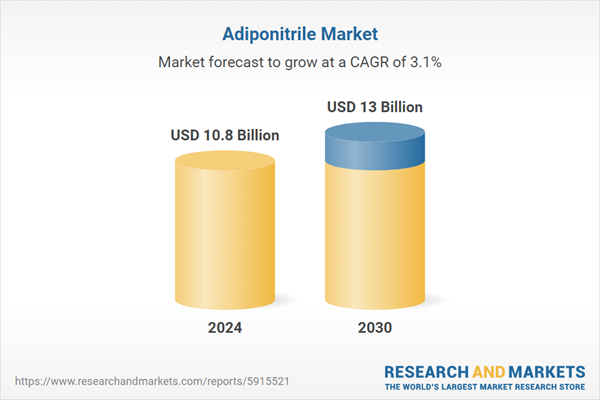Speak directly to the analyst to clarify any post sales queries you may have.
10% Free customizationThis report comes with 10% free customization, enabling you to add data that meets your specific business needs.
The automotive sector is one of the primary consumers of nylon 6,6, where it is used in components such as engine covers, airbags, and fuel systems. The increasing emphasis on lightweight vehicle production to enhance fuel efficiency and reduce carbon emissions has significantly driven the demand for adiponitrile. This trend is expected to continue, providing a favorable growth trajectory for the ADN market.
Key Market Drivers
Rising Demand for Nylon 6,6The global ADN market is closely tied to the demand for nylon 6,6, as adiponitrile is a vital raw material in its production. Known for its strength, thermal stability, and resistance to wear and chemicals, nylon 6,6 is indispensable in industries such as automotive, textiles, electronics, and industrial manufacturing. As the demand for nylon 6,6 increases in these sectors, the need for adiponitrile also rises. The automotive sector, in particular, is a major consumer of nylon 6,6, utilizing it to produce lightweight, durable components like engine covers, air intake manifolds, and fuel systems. The global shift toward lightweight vehicles has substantially boosted the demand for nylon 6,6, and by extension, adiponitrile.
Lightweight materials can reduce vehicle weight by up to 10%, improving fuel efficiency by 6-8%. This trend has been instrumental in driving the ADN market. Nylon 6,6 is also used extensively in high-performance textiles, including apparel, carpets, and industrial fabrics, valued for its durability and resistance to abrasion. With the global textile industry projected to grow steadily, the demand for nylon 6,6 in textiles will continue to rise. Furthermore, nylon 6,6 is crucial in electronics and industrial applications, such as electrical connectors and gears, due to its electrical insulation properties and heat resistance. The growth of the electronics market, particularly in emerging economies, further fuels ADN demand.
Key Market Challenges
Fluctuations in Raw Material Prices
Fluctuations in raw material prices present a significant challenge to the expansion of the global adiponitrile market. As the production of adiponitrile is closely tied to the cost and availability of key raw materials, any volatility in material prices - driven by factors such as geopolitical tensions, supply chain disruptions, or market speculation - can lead to instability in production costs.This uncertainty complicates pricing strategies, making it difficult for manufacturers to offer competitive and stable pricing. Such volatility may limit the wider adoption of adiponitrile across industries. To mitigate this challenge, industry stakeholders must implement effective supply chain management strategies, risk mitigation measures, and explore alternative sourcing options. Proactively addressing price fluctuations will strengthen the market's resilience, ensuring long-term growth.
Key Market Trends
Rising Demand for High-Purity Adiponitrile in Emerging Markets
A significant trend in the global adiponitrile market is the growing demand for high-purity ADN, particularly in emerging markets. The rapid industrialization and economic growth in these regions have increased the need for advanced materials such as nylon, used in automotive, textiles, and electronics. The demand for high-purity ADN is particularly strong in the automotive sector, where lightweight, durable materials are in high demand. Additionally, the electronics industry’s expansion in emerging markets further drives the need for ADN, which is integral to producing electronic components. Activated alumina plays a crucial role in the hydrogenation process required for ADN production, making it an essential component in meeting the rising demand for high-purity ADN.Key Market Players
- Asahi Kasei Corp
- Ascend Performance Materials
- BASF SE
- Butachimie
- INVISTA
- Kishida Chemical Co. Ltd
- Merck KGaA
- Spectrum Chemical Mfg. Corp.
- Tokyo Chemical Industry Co. Ltd
- Vizag Chemical International
Report Scope
This report segments the global adiponitrile market into the following categories, along with detailed insights into industry trends:
By Application:
Nylon Synthesis, HDI, Electrolyte Solution, OthersBy End User:
Chemical Intermediate, Automotive, Electrical & Electronics, Textile, OthersBy Region:
North America:
United States, Canada, MexicoEurope:
France, United Kingdom, Italy, Germany, SpainAsia-Pacific:
China, India, Japan, Australia, South KoreaSouth America:
Brazil, Argentina, ColombiaMiddle East & Africa:
South Africa, Saudi Arabia, UAECompetitive Landscape
Detailed profiles of the major companies operating in the global adiponitrile market are provided.Available Customizations:
This report can be customized to meet specific needs. Customization options include additional company profiling (up to five companies) and other tailored insights.This product will be delivered within 1-3 business days.
Table of Contents
Companies Mentioned
- Asahi Kasei Corp
- Ascend Performance Materials
- BASF SE
- Butachimie
- INVISTA
- Kishida Chemical Co. Ltd
- Merck KgaA
- Spectrum Chemical Mfg. Corp.
- Tokyo Chemical Industry Co. Ltd
- Vizag Chemical International
Table Information
| Report Attribute | Details |
|---|---|
| No. of Pages | 184 |
| Published | February 2025 |
| Forecast Period | 2024 - 2030 |
| Estimated Market Value ( USD | $ 10.8 Billion |
| Forecasted Market Value ( USD | $ 13 Billion |
| Compound Annual Growth Rate | 3.1% |
| Regions Covered | Global |
| No. of Companies Mentioned | 10 |









